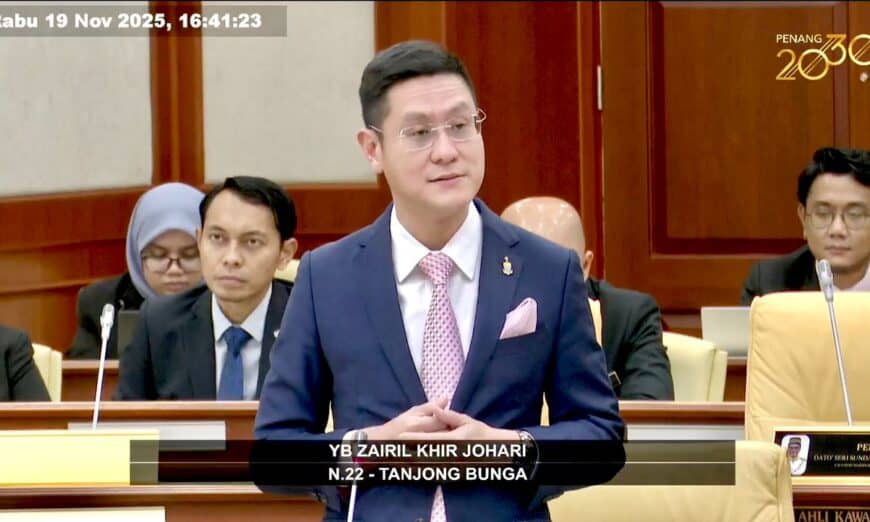PENANG will face a “life-and-death” situation within the next decade if it fails to secure the opportunity to purchase 500 million litres per day (MLD) of treated water from Perak under the Perak–Penang Water Project.
In his winding-up speech at the Penang Legislative Assembly, state Infrastructure, Transport and Digital Committee chairman Zairil Khir Johari (PH–Tanjong Bunga) issued this stark warning as he explained the importance of Penang Water Supply Corporation (PBAPP) signing a Memorandum of Understanding (MoU) with Konsortium PKNPk–Gamuda (a joint venture between Perbadanan Kemajuan Negeri Perak and Gamuda) to purchase at least 300 MLD of treated water from Perak from 2031 onwards.
“If we do not implement this project now, and the opportunity to purchase 500 MLD from Perak is missed, there will come a time — not long from now, perhaps 10 years from today — when all raw water sources in the state are fully utilised.
“If, by that time, the Federal Government and the Perak State Government are not aligned, Penang will face a life-and-death scenario. Therefore, I pose this question to the House: Can we put a price on water security?” Zairil asked.
He said PBAPP would bear an annual capacity charge of RM210 million and a purchase rate of RM1.70 per cubic metre of treated water from Perak as operational expenditure (OPEX). The agreement spans 40 years with a mid-term review in the 21st year, and carries a minimum supply quantity of 300 MLD.
During the budget debate, Lee Khai Loon (PH-Machang Bubuk) had questioned whether the state government had been pressured into accepting an unfair condition, and why the Federal Government was not covering the RM210 million annual charge as capital expenditure (CAPEX), as is commonly expected for inter-state projects.
Addressing these concerns, Zairil said the pertinent question that should be asked was whether the RM210 million capacity charge was reasonable.
“PBAPP has conducted due diligence by comparing the cost had the project been executed under a Build-Operate-Transfer (BOT) model with the Federal agency, the Water Asset Management Company (PAAB), as was done for the Sungai Muda and Sungai Perai water treatment plant (WTP) projects.
“After conducting this due diligence, considering all costs — including WTP construction, land acquisition, pipelines connecting the WTP from around Bukit Merah to Sungai Kerian in Penang, financial costs including loan interest, maintenance, and infrastructure upgrades over 40 years — PBAPP concluded that the cost offered by PKNP-Gamuda is competitive,” Zairil said.
“After evaluating all costs, including WTP construction, land acquisition, pipelines connecting the WTP from around Bukit Merah to Sungai Kerian in Penang, financial costs such as loan interest, maintenance and infrastructure upgrades over 40 years, PBAPP concluded that the price offered by PKNPk–Gamuda is competitive,” he said.
Responding to suggestions by several assemblymen that the Federal Government should fund the RM210 million charge, Zairil clarified that the Federal Government typically finances only raw water infrastructure.
“For this Perak water project, the Federal Government will cover an estimated RM5 billion to construct sourceworks and raw water transfer infrastructure from downstream of the Chenderoh Dam to Bukit Merah via a tunnel. Meanwhile, the cost of treated water infrastructure — such as the WTP and pipelines to Penang — is borne by the Perak State Government,” he said.
He added that PBAPP is purchasing the treated water not for its own use, but to supply consumers, including non-domestic users in rapidly developing industrial areas such as South Seberang Perai (SPS).
“This capacity charge is imposed by the Perak State Government because all infrastructure costs for producing this treated water must be borne by them to build a 500 MLD water treatment plant exclusively for Penang’s use.”
At this point, Chief Minister Chow Kon Yeow (PH–Padang Kota) interjected to ask whether PBAPP could construct the required facilities at a lower cost.
In response, Zairil said: “If PBAPP were to implement it on its own, it would be impossible because Sungai Perak is located in Perak, not Penang.”
Earlier, he had pointed out that if PBAPP were to undertake the 500 MLD project and its supporting infrastructure under a BOT model with PAAB, the cost would be roughly the same, or potentially higher based on PAAB’s financial projections. The only difference, he said, would be that the RM210 million charge would shift from OPEX to CAPEX.
Story by K.H. Ong
Pix by Alissala Thian

